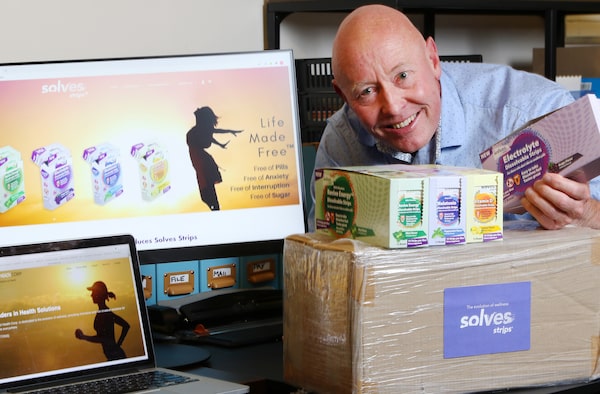
Innosol Health's Michael Kuhbock shows off some of the company's products in his Calgary office on Aug. 20, 2020.Dave Chidley/The Globe and Mail
Calgary-based Innosol Health Corp. is a small business with a big international reach. It was primed to grow its sales efforts this past spring, the busiest time of the year for trade shows in the supplements market, but then the novel coronavirus pandemic hit and changed everything.
“It’s the best time to meet with wholesalers and distributors,” says Michael Kuhbock, president of Innosol Health, which has been operating for about two years. “You’d try to get purchase orders in place and then go on your merry way.”
But COVID-19 botched those plans, shutting down international borders to most travel, especially the U.S, which is the largest market for the maker of Solves Strips, dissolvable vitamin and other edible strips. “That whole traditional sales cycle in the U.S completely shut down.”
Sales plummeted, and Innosol looked online to restart its revenue streams. Suddenly e-commerce – which was previously used to serve individual consumers – became the company’s primary means to generate sales and receive orders from U.S. and overseas customers.
It’s a familiar song sheet that many Canadians exporters are singing from in recent months. Unable to engage via traditional sales strategies, such as travelling to meet customers, these businesses turned to online tools that had often previously been second-string options, says Peter Hall, chief economist with Export Development Canada (EDC).
“E-commerce adoption is something that occurred far more incrementally before COVID happened.”
Now, many exporters have put e-commerce and other digital tools front and centre to avoid going over a financial precipice.
In fact, a recent EDC survey of more than 100 Canadian exporters point to e-commerce being a life preserver during the pandemic.
The July study, which focused on several challenges faced by exporters, revealed almost one-third of respondents were investing in their online capabilities due to the novel coronavirus.
“That’s quite substantial if that’s representative of the entire panoply of Canadian exporters,” Mr. Hall notes, adding 16 per cent of respondents developed an online strategy where they didn’t have one previous to the pandemic.
Additionally, sales through e-commerce grew substantially, the survey found. “What we saw actually even during COVID was that about half of our respondents said they were doing at least half of their sales online at the start of April, but those online sales grew to two-thirds by May,” says Mr. Hall, noting the survey did not ask businesses to specify how exactly they were using e-commerce and similar resources.
Winnipeg-based Richlu Manufacturing, the maker of Tough Duck workwear, saw a massive jump in e-commerce traffic.
President Gavin Rich notes the firm saw e-commerce sales increase about 245 per cent over the previous year. “E-com through our customers was growing prior to COVID, but we saw a huge spike since March and early April.”
The company does not sell directly to consumers, nor does it operate its own e-commerce portal for its retail partners. But leveraging e-commerce tools had long been part of its overall strategy to adapt to changing market conditions, including the growing importance of e-commerce for its own customers.
“Our model … for our e-com customers that we partner with is to fulfill orders for them,” Mr. Rich explains. “So, while we’re not doing the front-end selling, with that relationship with the [end user] customer, we are supporting the back end of those retail relationships.”
For example, when a major retailer receives an order via its own e-commerce site for Tough Duck’s industrial face masks and other personal protection equipment, Richlu prepares the order and ships it to its client or the client’s customers directly.
Because the family-owned business had this process in place for a few years already meant it experienced few hiccups during the pandemic. Its established e-commerce infrastructure also helped to avoid layoffs. As a result, profits are actually up year-to-date, notes Mr. Rich.
Although e-commerce had been an increasingly important strategy for exporters before COVID-19, it’s become an absolute must-have for many Canadian firms during the pandemic, says Darryl Julott at Digital Main St. in Toronto.
“This has been one of those ‘adapt or die’ moments,” says Mr. Julott, a senior manager at the non-profit that helps small businesses better use digital tools, including e-commerce. “We always tell our clients: ‘Shop local; sell global.’”
Many smaller clients may not be exporters, per se, but by developing e-commerce, they can be by selling their locally sourced products abroad.
“You can be based in Toronto and selling to customers in New York,” he says. “These small businesses may not consider themselves a quote/unquote exporter, but that’s what they’re doing.”
For Innosol, however, the U.S, Latin American and Asian markets are key sources of revenue. Prior to COVID-19, about half of sales were done face-to-face through a small sales force. Now roughly 90 per cent of its revenues are generated via e-commerce.
Mr. Kuhbock notes a return to normalcy is still desirable. Despite all the technologies – including e-commerce portals and videoconferencing – landing new clients often requires a human touch. That said, its efforts to expand e-commerce have led to new sales leads from the U.K. and elsewhere.
Mr. Rich says the view is similar at Richlu. The company has spent the past few months helping its clients expand their own e-commerce abilities while experimenting with innovations like a digital showroom to allow buyers to see their products.
“COVID has taught us a lot of great lessons about how technology can help, but you still need to meet with people,” Mr. Rich adds. “We still need to touch and feel products and see the whites of each other’s eyes.”